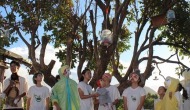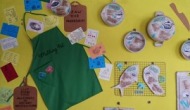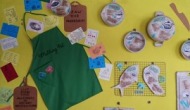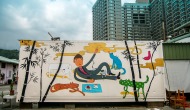電子報
Art Trails: BCS as an Archaeological Site IV
BCS is like a dreamland in which art can be found anywhere. Upon entering the main gate of the studio, one may discover an installation by artist WU Yi Chien titled “Document XIV” on the ground. Phonetic symbols composed of inset terra cotta bricks in cement spell out the names of artists who had worked and shown at BCS from 1996-2000 in chronological order.
尋跡.竹圍創作考古紀(肆)
一進大門,地板上踩到的是巫義堅的作品《文件十四》。2001年巫義堅在工作室的廣場上用紅磚、水泥等材料,以編年的順序、注音和拼音構成的符號組合,將1996-2000年曾在工作室創作或發表的藝術家的姓名逐一排列,整個地板空間被函化為一個具有書寫集體記憶、回顧歷史的觀念場域,成為一件「藝術介入空間」的真實作品。
Art Trails: BCS as an Archaeological Site III
Every artist visiting BCS is invited to leave a personal cup at My Cup as a gesture for homey comfort. Not only does the space resemble a family dining room for satisfying meals over tea, it serves also as a site for exhibitions. The inscribed pots and pans on the wall are documentations of Filipino artists Marika CONSTANTINO and Anjo BOLARDA’s 2015 project, The Melting Pot, in Taipei.
尋跡.竹圍創作考古紀(參)
「買杯」音源於"My Cup",每位藝術家都能在這裡置放一個屬於自己的杯子,好好的吃頓飯、喝杯茶,讓身體獲得充分休養。但「買杯」的功能不僅於此,也是藝術家的創作空間……
Art Trails: BCS as an Archaeological Site II
“Are those the Seven Sages of the Bamboo Grove?” That's right—the artist himself, the 4 BCS onsite dogs (A-Won, Niu-Niu, Ann-Ann, Duen-Duen), Ki Ki the cat, and a little bird can be spotted on the surface of one of BCS’s warehouses, making up “Leisure Time in the Bamboo Forest,” a scene different from that of the Jing Dynasty Seven Sages, a group of literati that had found peace and refuge in simple, rustic life during political unrest in the 3rd century China.
尋跡.竹圍創作考古紀(貳)
「啊~竹林七賢!」沒錯,裡面有七隻長眼睛的動物,包括羽祐、四條駐村狗(阿旺、牛牛、安安、惇惇),貓咪KiKi以及天上的飛鳥。對照著晉朝的阮籍、嵇康等竹林七賢,這《竹林棲閑》有著不同的意涵。







